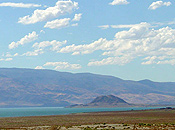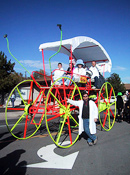Black Rock City has all the characteristics of other municipalities of similar size, including a need to maintain diplomatic relations with numerous government agencies. And government is sure to bring politics. The paradoxical result is that the apolitical art event known as Burning Man is highly engaged in politics from the local area all the way to the national level.
The Black Rock Desert National Recreation Area is public land regulated by the federal government via the Bureau of Land Management (BLM). The BLM headquarters in Washington, D.C. oversees the agency’s law enforcement in the Black Rock Desert. In addition to management of the National Conservation Area (NCA) surrounding the Black Rock Desert, Burning Man’s annual Special Recreation Use (SRP) permit is governed by the BLM’s office in Winnemucca, Nevada.
But the bureaucracy does not stop there. The Black Rock Desert straddles the boundaries of three Nevada counties: Washoe, Humboldt, and Pershing. For the past several years, Black Rock City has occupied federal land within the boundaries of Pershing County.
 Throughout the year, two BLM Rangers police the NCA. During the Burning Man event, however, the BLM brings in officers from other states and also contracts with local agencies from Washoe and Pershing Counties to provide additional support for public safety and law enforcement. The Nevada Highway Patrol has jurisdiction to patrol Highway 447, over which virtually everyone attending Burning Man travels. California Highway Patrol oversees highway safety north via Cedarville. The Nevada Department of Transportation regulates road conditions on this corridor to Black Rock City. Part of this highway cuts through the Pyramid Lake Paiute Reservation.
Throughout the year, two BLM Rangers police the NCA. During the Burning Man event, however, the BLM brings in officers from other states and also contracts with local agencies from Washoe and Pershing Counties to provide additional support for public safety and law enforcement. The Nevada Highway Patrol has jurisdiction to patrol Highway 447, over which virtually everyone attending Burning Man travels. California Highway Patrol oversees highway safety north via Cedarville. The Nevada Department of Transportation regulates road conditions on this corridor to Black Rock City. Part of this highway cuts through the Pyramid Lake Paiute Reservation.
Are you still with us? Good, because there’s more. State and local health departments inspect the Center Camp Cafe as well as theme camps that give out food and beverages as part of Black Rock City’s gift economy. And, of course, Black Rock City has been visited by politicians and judges from California and Nevada, along with federal officials.
On one hand, Black Rock City has many characteristics of anarchy. Obviously, however, Black Rock City is at the vortex of numerous overlapping government jurisdictions. Managing these government relationships successfully has time and again culminated in the Man burning on Labor Day weekend.
Year-Round Government Relations
Washoe County
Over the past several years, press reports have illuminated activities at Burning Man’s work ranch and its work towards compliance with Washoe County’s zoning laws. More recently, the organization has launched formidable efforts to bring operations into compliance.
In 2004, the Washoe County Planning Commission issued several Special Use Permits, which enabled the Burning Man Project to legally use Black Rock Station as a staging and storage area for the event. At a hearing where one of these permits was granted, only one neighbor spoke in opposition to the permit. The tide had turned from just a year before, when a group of neighbors had protested a similar permit application. In fact, one neighbor with a Nevada contractor’s license was subsequently employed by the organization to help bring Black Rock Station into county compliance.
The Burning Man organization now has a positive relationship with Washoe County, as well as a safe, compliant work facility on which to store materials and construct items for the event.
Pershing County
Located within the region of Nevada known as “Cowboy Country”, Pershing County is in many ways the final frontier for Burning Man’s political odyssey. Although the event is held within the boundaries of that county, the vast majority of participants travel through Washoe County on Interstate 80 to get to Black Rock City. The result is that Washoe County benefits from sales of gas, ice, food, and supplies, while Pershing County’s businesses do not profit as much. The only place to fix blame is on the geography.
Also, Pershing County has no option comparable to the BLM’s congressional authority to charge large fees for Burning Man’s use of public land. Yet the county hosts the event within its borders, and the sheriff helps to police Black Rock City. To add insult to injury, Pershing County is currently undergoing an economic downturn.
All these compelling reasons have led Pershing County to seek a way to implement a festival permit that could mean exorbitant fees. While sympathetic to our neighbors’ plight, the Burning Man organization is not in a financial position to pay excessive fees that are not legally warranted. Utilizing the efforts of Burning Man’s paid and volunteer attorneys, the organization has done its legal homework. The organization has been advised that Pershing County’s recently passed ordinance is unconstitutional, since Congress has given the BLM the exclusive right to regulate the permit process in the Black Rock Desert National Recreation Area.
Nevertheless, in an effort to help the county, Burning Man has added organizations in Pershing County to the list of recipients for charitable donations from ice sales. Whether the issue is resolved politically or legally, the Pershing County ordinance will come to the forefront in 2005.
State of Nevada
 It’s clear that Burning Man has become part of Nevada’s landscape. State tourist brochures mention Black Rock City. Also, in 2004 Burning Man was represented in the Nevada State Parade by several mutant vehicles and by participants from northern Nevada. The parade entry even received an award.
It’s clear that Burning Man has become part of Nevada’s landscape. State tourist brochures mention Black Rock City. Also, in 2004 Burning Man was represented in the Nevada State Parade by several mutant vehicles and by participants from northern Nevada. The parade entry even received an award.
Federal Government
In 2004, two members of the Black Rock City Board and one senior staff member visited officials at the BLM headquarters in Washington, D.C. This friendly visit involved no specific agenda. During the meeting, BLM officials happily pointed out mentions of Burning Man in a 2004 National Geographic article, extended to be a small book about the Bureau.
Also in 2004, for the first time ever, the BLM made more money from recreation fees than from cattle grazing fees. Considering that Burning Man is the BLM’s largest recreational client, this change has been made possible by every person who purchased a ticket to Burning Man 2004. In that sense, every participant is a diplomat.
On-Playa Government Relations
In years past, event organizers have engaged in proactive outreach by visiting officials of all levels of government. Over time, officials and others who should further understand the event have shown interest in accepting invitations to tour our city. Special day visitors to the event come to First Camp to begin their experience. Typically, government officials meet primarily with Board members and senior staff members. In 2004, however, a new team of individuals from various departments was assembled to help host government and other special visitors on the playa. The new External Relations Team (XRT) consists of board members, senior staff, media team members, members of the Law Enforcement and Agency Liaison (LEAL) team, and various others. The XRT took on the task of greeting government officials and coordinating specialized tours of Black Rock City for them.
In the weeks before the event, the team created reference kits and mailed them, along with invitations to visit the event, to several key figures. The materials included a “What, Where, When” Survival Guide, the latest newsletter, and resource guides. One of these, “What is Burning Man doing for Nevada”, explains Burning Man’s financial, environmental, and artistic contributions to our host state.
The team invited members of Congress from both Nevada and California, as well as state assembly members, San Francisco Board of Supervisors and staff, Washoe County Planning Commission, even business owners from Cedarville, California.
Many decided to attend and take one of the scheduled tours. In 2004, the team conducted a total of five tours for over 25 guests. Once on the playa, the team escorted the guests from the Gate to the Greeters Station, where they were warmly welcomed, and then on to First Camp for orientation and introductions to Board members and senior staff.
The tours were conducted in the team’s art vehicle of choice: the Millennium Phantom, the only cocktail lounge anywhere sporting a rotating radar array from an F-4 Phantom attack fighter. Staff provided background on the event and the art, and of course the community and culture of Burning Man. When the Millennium Phantom landed back at First Camp, the visitors were each given a pouch with a sticker, a patch, and of course a lighter, in keeping with Burning Man’s gifting philosophy.
In an only-on-the-playa moment, one tour happened to pull up to the Temple of Stars right as artist David Best was coming out. He met one of the guests and mentioned the work’s theme of forgiveness and suicide. The guest broke down in tears. Her father had taken his own life. The rest of us stepped back to allow them space and reflected on how Black Rock City seems to be a magnet for moments like that.
Some of the guests lingered for hours, taking in the vibe and the view, and others stayed for days. Without exception, each of these visitors said they had come to understand what the event is about from a perspective they didn’t have before, and all pledged to continue supporting Burning Man. One high note was having the federal prosecutor for the area spend time with her staff and BLM officials in BRC, gaining context for the kind of cases that might come before her. The only sour note was when the Millennium Phantom ran out of gas in a whiteout on the deep playa, but our guests – local business owners and ranchers – took the experience in stride and kept spirits up with tales of the original inhabitants of the area.
For 2005, the tours will probably increase. More time will be allowed for shuttling people from the Gate to First Camp. Planning should consider how much water, gas, and food to bring on a tour in case a prolonged whiteout demands unexpected resources.
Looking back, Burning Man has been largely successful with its government relations. Looking forward, new hurdles will always be erected, but nothing that the Man can’t jump.
Submitted by,
Ray Allen & Tom Price

